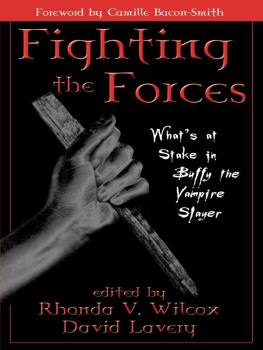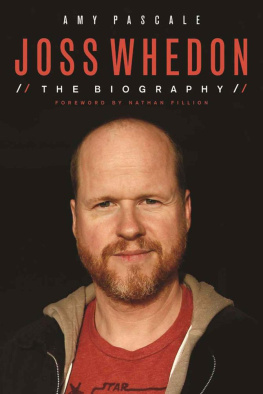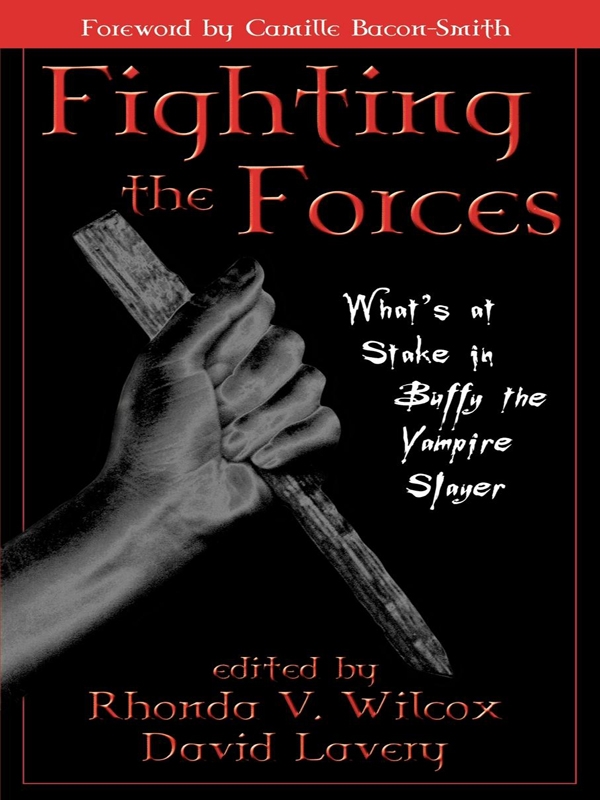First of all, we both wish to thank all the wonderful contributors to this volume (and indeed all those who wanted to contribute)without them we would have no book. In particular, we wish to thank Elyce Rae Helford, both for introducing us to the folks at Rowman & Littlefield and for agreeing to comment on parts of the manuscript, and Mary Alice Money, for help during e-mail difficulties (among many other reasons). Thanks also to Christine Gatliffe of Rowman & Littlefield for her encouragement of the project. We are indebted to Richard Gess for the cover photography (and to Rachel Pomberg for lending a hand). And, above all, we thank the creators of our primary source.
From David Lavery : Thanks to Rhonda Wilcox for her most excellent collaboration during a very difficult time in her professional life. Thanks to my family, who have endured my newfound obsession. And special thanks to my students Chris Peltier, Erin Gonzalez, Becky Short, and Brian Logginswithout their powers of persuasion (and videotapes), I would never have come over to Buffy.
From Rhonda Wilcox : Thanks first to David Lavery, for his energy, acuity, expertise, and generosity of mind. That my first time editing such a collection should be with David is a gift. Thanks to all my family and friends for their support and, even more important, their understanding of the significance of this work. Special thanks to my husband, Richard Gess (That was Tales of Brave Ulyssesits Cream), and my son, Jefferson Gess (Look, Spike can bite her because shes already dead): their enthusiastic attention and, ultimately, their patience were important contributions. I want to express appreciation, too, to Cindy Bowers, whose work as a list mistress years ago sparked early commentary about Buffy (on a list devoted to another series) by J. P. Williams, Catherine Siemann, and me, as well as Grace Lee, Cynthia Hoffman, and others I will wish I had named. Some who will read this book know that I have been in a very stressful situation over the course of the project: I am one of over a dozen people who have been involved in a particular fight for freedom of speech and against sexual discrimination. It has meant a great deal to be part of a supportive group during this timeas any Buffy watcher could tell you. I therefore want to add my thanks to Marlin Adams, Jeanne Beckwith, Don Butts, Brett Cox, Gary Cox, Tricia Daughrity, Bill Day, Deborah Johnston, Mary Alice Money, Rhonda Morgan, and Marvin Thomas and also to AAUP members Luanne Fowler, Jon House, and Hutch Johnson (not to mention the members of the Popular Culture Association in the South). You all have helped me to keep going.
Sooner or later, everyone has to decide whether or not to fight the forces.
Bibliography
Abbott, Stacey. A Little Less Ritual and a Little More Fun: The Modern Vampire in Buffy the Vampire Slayer. Slayage: The Online International Journal of Buffy Studies Number 3 (June 2001) < http://www.middleenglish.org/slayage/essays/slayage3/abbott.htm >.
Abrams, M. H. Natural Supernaturalism: Tradition and Revolution in Romantic Literature. New York: Norton, 1971.
Adams, Michael. Slayer Slang (Parts I and II). Verbatim: The Language Quarterly 24.34 (Summer/Autumn 1999): 14, 17.
Aldiss, Brian. Vampiresthe Ancient Fear. Gordon and Hollinger ixxi.
Allen, John L., Jr. Teens on Screen: How Teenagers Are Portrayed. National Catholic Reporter 35.2 (26 Mar. 1999): 17.
Allen, Robert C. Introduction to the Second Edition: More Talk about TV. Channels of Discourse, Reassembled. Ed. Robert C. Allen. Chapel Hill: U of North Carolina P, 1992. 130.
Anderson, Lisa M. Mammies No More: The Changing Image of Black Women on Stage and Screen. New York: Rowman & Littlefield, 1997.
Astle, Richard. Dracula as Totemic Monster: Lacan, Freud, Oedipus and History. Sub-Stance 25 (1980): 98105.
Auerbach, Nina. Our Vampires, Ourselves. Chicago: U of Chicago P, 1995.
Augustine. The Confessions of St. Augustine. Trans. Rex Warner. New York: Penguin, 1963.
Bacon-Smith, Camille. Enterprising Women: Television Fandom and the Creation of Popular Myth. Philadelphia: U of Pennsylvania P, 1992.
Barber, Paul. Vampires, Burial and Death: Folklore and Reality. New Haven: Yale UP, 1988.
Barlow, John Perry. Declaration of Independence for Cyberspace < http://www.clas.ufl.edu/users/seeker1/cyberanthro/decl-indep.html >.
Barreca, Regina. They Used to Call Me Snow White... but I Drifted: Womens Strategic Use of Humor. New York: Viking, 1991.
Barthes, Roland. A Lovers Discourse. Trans. Richard Howard. New York: Hill and Wang, 1978.
. Myth Today. A Barthes Reader. Ed. Susan Sontag. New York: Hill and Wang, 1982. 93149.
. The Pleasure of the Text. Trans. Richard Miller. New York: Hill and Wang, 1975.
Belensky, Mary Field, Blythe McVicker Clinchy, Nancy Rule Goldberger, and Jill Mattuck Tarule. Womens Ways of Knowing: The Development of Self, Voice, and Mind. New York: Basic, 1986.
Bellafante, Ginia. Bewitching Teen Heroines: Theyre All Over the Dial, Speaking Out, Cracking Wise and Casting Spells. Time 5 May 1997: 8284.
Bettelheim, Bruno. The Uses of Enchantment: The Meaning and Importance of Fairy Tales. New York: Vintage, 1989.
Bloom, Harold. The American Religion: The Emergence of the Post-Christian Nation. New York: Simon and Schuster, 1992.
Boese, Christine. The Ballad of the Internet Nutball: Chaining Rhetorical Visions from the Margins of the Margins to the Mainstream in the Xenaverse. 25 June 2000 < http://www.nutball.com >.
Bogle, Donald. Blacks in American Films and Television. New York: Simon and Schuster, 1988.
. Toms, Coons, Mulattoes, Mammies and Bucks: An Interpretive History of Blacks in American Films. 3rd ed. New York: Continuum, 1996.
Bosky, Bernadette Lynn. Making the Implicit, Explicit: Vampire Erotica and Pornography. Heldreth and Pharr 21766.
Bowers, Cynthia. Generation Lapse: The Problematic Parenting of Joyce Summers and Rupert Giles. Slayage: The Online International Journal of Buffy Studies Number 2 (Mar. 2001) < http://www.middleenglish.org/slayage/essays/slayage2/bowers.htm >.
Braun, Beth. Buffy Meets Freud: A Psychoanalytic Look at Televisions Vampire Slayer. Augusta: Popular Culture Association in the South Conference, 810 Oct. 1998.
Breton, Rob, and Lindsey McMaster. Dissing the Age of Moo: Initiatives, Alternatives, and Rationality in Buffy the Vampire Slayer. Slayage: The Online International Journal of Buffy Studies Number 2 (Mar. 2001) < http://www.middleenglish.org/slayage/essays/slayage2/bretonmcmaster.htm >.
Bronfen, Elisabeth. Over Her Dead Body: Death, Femininity and the Aesthetic. New York: Routledge, 1992.
Brown, Lyn Mikel. Raising Their Voices: The Politics of Girls Anger. Cambridge: Harvard UP, 1998.
Brown, Mary Ellen, ed. Television and Womens Culture: The Politics of the Popular. London: Sage, 1990.
Bunson, Matthew. The Vampire Encyclopedia. New York: Crown, 1993.
Burke, Kenneth. A Grammar of Motives. Los Angeles: U of California P, 1969.
. Language as Symbolic Action. Los Angeles: U of California P, 1966.
. A Rhetoric of Motives. Los Angeles: U of California P, 1969.
Callandar, Michelle. Bram Stokers Buffy: Traditional Gothic and Contemporary Culture. Slayage: The Online International Journal of Buffy Studies Number 3 (June 2001) < http://www.middleenglish.org/slayage/essays/slayage3/callandar.htm >.
Campbell, Bebe Moore. Your Blues Aint Like Mine. New York: Ballantine, 1992.







